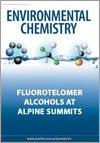EN16184Studying selenium and sulfur volatilisation by marine algae Emiliania huxleyi and Thalassiosira oceanica in culture
Environmental context. Volatile selenium compounds from the oceans may ultimately be an important selenium source for agricultural soils. It has been hypothesised that marine algae are responsible for volatile selenium emissions, but in laboratory experiments, we observed minimal volatile selenium production by two marine algae known to produce large amounts of volatile sulfur. Instead, we found hints that bacterial processes may be important in the production of volatile selenium in the oceans.




